Researching your German ancestors? If so, I bet you have come across that spidery German handwriting, so beautiful yet elusive to our 21st-century eyes. But it doesn’t have to be so difficult. Below are 20 tips (combined, for your convenience, from my popular posts Ten Tips for Deciphering Old German Handwriting and Ten More Tips for Deciphering Old German Handwriting) to help you put together the puzzle pieces of your past. And as always, if you would like the help of a professional German genealogy translator, contact me here. I would love to hear from you.
Twenty Tips for Deciphering Old German Handwriting
1. Identify letters by the clues they offer. While deciphering old handwriting can feel like solving an incredibly difficult puzzle, the letters themselves often provide nice little clues for us. For example:
* “h” has a loop both above and below the line. It is easily identifiable in the word “Tochter” (daughter) below.
 |
 |
* “u” has a little “swoop” (my non-technical term) above it and “i” has a dot above it. Word of warning: sometimes the swoop or the dot can be slightly to the right of the actual letter itself. Notice also how everyone’s “swoops” can be slightly different, as seen in the real-life example of the word “gut” (good) below.
 |
 |
 |
* A straight line above a letter can mean that it is an “n” or an “m” and that there should be two of them. For example, “kommen” (to come) would likely be written with one “m” with a straight line above the letter. Word of warning: Sometimes the “u-swoops” are written as straight lines. Umlauts can be written as straight lines as well.
 |
This example reads “den es” with a straight line above the “n”, which results in “denn es” (because it).
2. Use your insider information to differentiate between the letters that are agonizingly similar. Although I’m sure the inventors of Kurrentschrift weren’t trying to cause problems for 21st-century readers, they made some of those letters very, very similar to one another. However, if you are familiar with their subtle differences, you can beat the system.
* “e” and “n”: The “n” (left image below) is written as one unit in a single stroke, while the “e” (right image) is written with two strokes. The “n” is more jagged-looking than the “e”, while the “e” is usually written as a more narrow letter. Notice how the “e” is more narrow than the “n” in the real-life image of “denn” above.
 |
 |
* “n” and “m”: My trick for distinguishing between “n” and “m” in a word is to count the points at the bottom of the letter. The “n” has three total points at the bottom, while the “m” has four. This sounds obvious, but when you have a word with “en” or “em”, all these letters start to look the same. It helps me to identify the “e”, separate it off from the rest of the word with a line, and then count the points at the bottom of the next letter to see how many there are. In the example below, the word is “mein” (my). You can identify the “m” at the beginning of the word by counting the four points at the bottom and the “n” at the end by noticing the two points after the “i.”
 |
 |
 |
3 . Love your letter “S”. Although “s” can be quite tricky, as there are at least three different ways to write it, it is usually pretty easy to identify as each version is somewhat unique from the other letters in the alphabet (none of this e-n-m difficulty).
 |
These three letters above are all “s”. The first letter shown is used at the beginning of a lowercase word or a syllable (i.e. in “schreiben” – to write). The second “s” is used at the end of a syllable/word (i.e. in “es”- it). The final is the capital “S”, used for nouns (always capital in German) and names. See the word “es” in the example of “denn es” in Tip 1.
4. Know your abbreviations. If you come across a letter or two all by themselves, it could easily be an abbreviation. This website allows you to type the German abbreviation into its search machine to see what the German word could be. A very common example in genealogical documents is “u.” for “und” (and).
5. Keep your mind in the past. By this I mean – don’t let your brain automatically read the letters as it would a modern-day document. Many of the letters in Kurrentschrift look similar to our cursive today, but are not actually the same letter. It is easy for your mind to simply read them as the letter you learned in school, but don’t give in! The most difficult for me at the beginning was constantly thinking an “e” was an “n”.
6. Play hangman. Once you have identified as many letters in a word as you can, write them out, leaving a blank for the letter(s) you don’t know. With your knowledge of the context or of the German language, see if you can figure out what the missing letters are. I also find this website, WordMine.info, very helpful. It allows you to type in either the beginning or end of the word and then provides you a list of all the possible German words with those exact beginnings or endings.
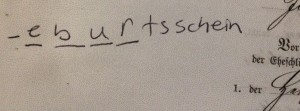 |
In this example, I filled in the letters I recognized one by one, until only the tricky letter at the beginning was left. It was then obvious that this word must be “Geburtsschein” or “birth certificate.
7. Forget all you know about writing rules. Punctuation? Who needs it? Writing one word on one line? Not for our ancestors! Many historical writers simply did not use periods or commas. While this usually doesn’t make handwriting transcription too difficult, the lack of line rules does. What do I mean by that? In a letter or document, a word may start on one line, and then, without a dash or any type of punctuation, simply continue onto the next line. So if the letters at the end of the line do not seem to be forming any type of word, remember to look to the next line to see if the word continues there.
8. Google, google, google. I can’t imagine translating without it. With the possibility of old fashioned words in historical documents, you may not recognize every word you come across. If you aren’t exactly sure of your transcription, try typing variations of the word into Google search to see which version most frequently appears in other texts and see if they make sense within your document and for your current transcription. The same can be true for last names. Deciphering names can be difficult because there is no context to tell you if you are right or wrong. Try typing the name you think it could be into Google and see if other examples come up. If not, you probably have a letter wrong. This website is also a great tool, showing you the frequency of a last name in the different regions of Germany.
9. Become geographically-inclined (or just use Google Maps). If you know from the context of the document that a certain word is a city or district, but aren’t sure of the exact letters, use Google or Google maps to see if you can find a city that matches your possible transcription in the area where your document is from. The Google auto-correct “Did you mean….” is often very helpful.
10. Always let the document be your guide (Jiminy Cricket’s second piece of advice).
 |
Everyone’s handwriting is different, and a certain letter from an 1890 birth certificate may look completely different from the same letter in a World War II military record. If you are able to identify a letter in your current document, remember it, and then look for other occurrences of the same letter throughout the text. I recently translated a letter in which the “s” looked like our modern “r” (I know, I know, I said the “s’s” were easy-they usually are). Once I realized this was an “s” based on my hangman type game, I was able to easily identify other “s’s” in the document and therefore many other words.
11. Get hip with the lingo. Letter writers of the past often used the same phrases over and over in writing, just as we do in English today (“Thank you for your e-mail”, “Attached please find”, etc.). Being familiar with these common phrases helps in transcribing the old handwriting, as it allows you to better recognize the rest of the sentence. Some phrases that you might find in historical German letters include:
| Ich habe deinen Brief erhalten/bekommen. | I have received your letter. |
| Seid herzlich gegrüßt. |
Literally: Be greeted affectionately. English: We send you all our warm regards. |
| Was Gott tut, das ist wohlgetan. | A German Saying: “What God does is well done” |
| Vielen herzlichen Dank. | Many warm/heartfelt thanks. |
| Wir sind alle gesund. | We are all healthy. |
As discussed above, abbreviations also appear frequently in old German documents. The most common abbreviations include: “d.”, meaning “den” (the) before a date, as in “d. 2te February (the second of February), “u.” for “und” (and), and “geb.” for “geboren”, meaning “née.” For more help with German abbreviations, check out the post 19 Most Common Abbreviations in German Genealogy.
12. Master the tiny details of the letters. In tip number two, we discussed the minute differences between “e”, “n” and “m”. Unfortunately, these aren’t the only letters in Kurrentschrift that look almost the same. Other examples include:
* “N” and “St” – These two letters are very similar and are often difficult for even a professional to tell apart. If you look closely, however, you can see that the bottoms of the two letters are (or should be) different. The “N” finishes with a swoop to the right, while the “St” finishes with the crossing of the “t” itself. However, in actual documents, this can still be difficult. The 1920s example of “St” in Stunde (hour) on the bottom also finishes with a swoop to the right and thus even more strongly resembles an N. Here, however, you can differentiate it from an “N” in the fact that the “t” is (slightly) crossed, as opposed to the “N” in “Nachmittag” (afternoon) above.
 |
 |
 |
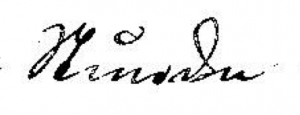 |
* “B”, “C” and “L” – If you look at the three capital letters below, you might be a little alarmed. They are incredibly similar. However, if you know the clues to look for, you will be able to tell them apart. The “C” (middle) is easy to differentiate from the other two letters as there is no loop at the top. Just a simple stroke with a little downward hook at the top right. As for the “B” (left) and the “L” (right), the “B” is different in that it has a little straight line coming off the bottom swoop, much like our lowercase cursive b today. Notice this line in the left word “Brief” (letter) compared to the rather fluid finishing of the “L” on the right in the word “Liebe” (dear). “C” is not a very common letter in German, and is often only found in names, such as “Christian.”

* “v” and “w” –These lowercase letters look similar, but are actually quite easy to tell apart. While they both have the loop on the right, the “v” only has one stroke before the loop, while the “w” has two. Below, “v” is on the left, with a real-life example of the word “vielen” (many). “w” is center, followed by an example of the word “wird” (will). Finally, the last column shows both letters in the words “verkauft werden” (will be sold). Notice how the “w” has one more stroke before the loop than the “v” in this sample from an 1868 letter.
|
|
  |
13. Understand the importance of occupations. Just as one of our first questions for a new acqaintance is “What do you do?”, our ancestors also placed a great deal of importance on their occupations. Therefore, on any certificate, the occupation of a person was listed before the person’s name. For example, a certificate may read that “the farmer Johann Schmidt appeared before the undersigned registrar”, with farmer (Bauer) preceding the name of the person involved.
The level of one’s occupation was also important. Occupation levels included:
“Lehrling” – apprentice
“Geselle” – journeyman (apprenticeship complete)
“Meister” – master
These levels, if listed, always follow the name of the occupation. For example, “Schuhmachermeister” is a person who is a master shoemaker. In the examples below, Friedrich Gottlieb Christian Eckhardt was a Schuhmachergeselle (first handwritten word, top image) before he was a Schuhmachermeister (last handwritten word, top line of bottom image).

14. Think horse-drawn carriage driver. Speaking of occupations, many occupations that were around in the past are no longer around today. Or, if the occupation is still around today, there may have been a different word for it in the past. This website provides an A-Z list of old occupations with their modern-day German translation. If you don’t speak German, you can find the old-fashioned occupation of your ancestor in the left column, and then use a dictionary to translate one of the modern day names in the right column. In my experience, one of the most common occupations for women seems to have been “Näherin” (seamstress), while one of the most common occupations for men seems to have been “Bauer” (farmer). Edna M. Bentz’s book “If I Can, You Can Decipher German Records” has a great list of old-fashioned occupations as well.
15. Expect the unexpected. By this, I mean that words may not be exactly as they are in the dictionary today. Just as our English speaking ancestors used words such as “thee” and “thou”, our German speaking ancestors used different words too. If you transcribe a word and have absolutely no idea what it means, it could easily be a word no longer in use. This website offers a great German-German dictionary (started by the Grimm brothers) for old-fashioned German words.
But what if you still can’t find your word? In that case, if you are certain of your transcription, it very likely could be a spelling mistake on the part of the author. As German spelling did not become widely standardized until the end of the 19th century, words in letters and other documents were often spelled “creatively.” While this can make deciphering certain words rather difficult, it is slightly easier if you are aware of some of the more common mistakes. Below, some examples:
* a “t” might be substituted for a “d”
* a “g” might be substituted for a “k” or a “ch”
* an “f” could be substituted for a “v”
In the above example, the author of the letter writes “ich aich noch nigt” instead of the proper German spelling “ich euch noch nicht” (part of a sentence, literally “I haven’t…you yet.”) The “eu” is consistently replaced with “ai” in this letter and the “ch” with a “g”. Once you start to notice the common mistakes an author makes, you can identify these substitutions in other words in your document.
16. Keep on an eye on those Americans. If your German ancestors were in America, they might have included English words and place names in their letters. I’ve come across “Varmer” (farmer), “Kolorata” (Colorado), “daler” (dollar), and so on. So, if you cannot recognize a German word, take a step back and ask yourself if your ancestor could have been using some of their newly learned English.
17. Be street smart. The word for street in German is “Straße”, often abbreviated “Str.” If you know that a word in your document is a street, but can’t figure out which street it is, use this street-finder website to help you out. You type your ancestor’s city in “Suche im Strassenverzeichnis”, which then pulls up a map of the city and an A-Z list of street names. If you know at least some of the letters in your street name, this can help you recognize the correct transcription of the word.
18. Don’t be fooled by “normal” script. Names of people were often written in normal Latin script, just as the cursive script we use today. It is important to be aware of this fact – for example, you don’t want to see a letter “e” in a name and think that that is how an “e” is written in the rest of the document. Much the opposite – names were often signed one way, while the body of the document was written in Kurrent. This is especially true for church book registers.
In the example below, the author signs her name (Louise H) in “normal” script. You can see that there is no swoop above the “u” as in Kurrent, the “e” at the end of Louise is more like our cursive “e” than the Kurrent “e” that resembles our modern “n” and the “H” is nothing like the complicated Kurrent “H” that goes both above and below the line. However, in the rest of this document, the author would have used the Kurrent letters.
19. Understand the system. If you know the information that should be on a document, transcribing is much easier. Luckily, certificates from most regions of Germany/Austria have similar formats, providing the same information for the people involved. Some information you can expect on birth, baptismal, marriage and death certificates include:
* City, date
* Person’s name, occupation, city of residency, religion
* How the person was identified if previously unknown to the registrar (passport, baptismal certificate, military pass, birth certificate)
* Parents’ names, occupations, city of residency, religion, if they are deceased
* Witness’ names, occupations, city of residency, religion, age
* Signatures of those involved, witnesses and registrar
The First Page of a Marriage Certificate, Berlin 1888
For more information on marriage certificates in particular, check out 7 Tips for Reading German Marriage Certificates.
20. And finally, and most importantly, know when to take a break. You’ve almost finished your transcription, but there is still one frustrating word that you cannot figure out for the life of you. You want to persevere and finish, but my advice is: don’t. Take a break, and things will often look much clearer if you stop and come back later. I’ve experienced this a number of times: The transcription is just about finished, but that one last word is baffling me. I take a break, come back later or even the next day, and all of the sudden, the word is perfectly clear and I wonder how I didn’t see it before. As a linguist and not a scientist, I can’t explain how that happens, but it amazes me every time!
With these twenty tips, you should be well on your way to finding your German ancestors. And if you would like a professional to translate your documents, I’d be happy to help – contact me at language@germanologyunlocked.com. Until then, best of luck in your genealogy search!
Update: If you want help transcribing your genealogy documents, consider joining our Premium group – weekly access to live “office hours” where you can ask Katherine your tricky transcription and translation questions – and get immediate answers.
Image Credit: All original samples have been published with the permission of the client.
All Kurrentschrift letter samples are from the Kurrentschrift wikipedia page, except for “N” and “St”, which can be found here.


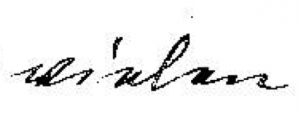




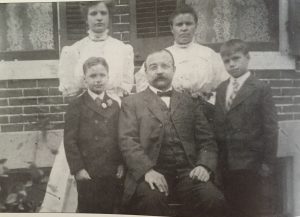

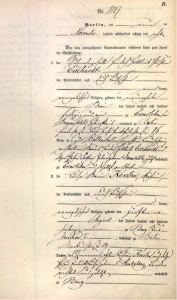

14 Responses
I love this post, not only because it reminded me of how I used to decipher the German Kurrentschrift handwriting of my father, but also because it gives great tips how to use some clues, abbreviations, etc..
Thank you Peter! I’m glad you found it helpful.
I can’t wait to try these tips on the stack of German letters sent to my husband’s mother. Thank you very much!
Hope they can be of help to you!
And feel free to let me know if you have any questions!
What great info!! This past year, I discovered my paternal side is full of German ancestors and I don’t know German. Drives me nuts each time I get a hit for a record written in German, especially when I’m positive there’s great nuggets of info in it! Next time I get a hit for a record in German, I’m going to use the info this post to try to decipher it! Thank you!!
I am looking for a translator of German letters into English from 1937-onward.
Hi Gail, Please send me an e-mail via the contact tab on the website. I look forward to hearing from you!
Hello! Is this still an active article? I have a short paragraph on the back of a photograph, and I’ve been told it is written in Kurrent. It is most likely an explanation of what is on the picture, because the person trying to translate it can make out a phrase about my grandma, Wilma, not standing or walking yet, as well as something along the lines of “Have a blessed Easter.“
I’m not working on genealogy, I simply have all of her pictures, and would love to know what is written on the back of the one I’m referring too.
Hi Stephanie, sounds like a nice picture. Please send me an e-mail at language@germanologyunlocked.com and we can go from there!
I have some family letters in German script dating from late 1800s into the early 1900s. I have personal and professional reasons for needing assistance with translation. My son speaks German but cannot read the handwriting. Do you provide the kinds of services that I need, or can you make a recommendation of someone who could help me? All of our elderly German family and friends are now gone, so I don’t know to whom I might turn.
Hi! I have an old German flax spinning wheel with the name address of the maker on the bottom. I’m having a hard time deciphering it. Can I get help here if I have a good photo? thanks so much.
I’ve been asked to translate some old letters. Your tips are Gold wert! Thanks for publishing this!
Glad it was helpful, A. Holzhausen! If you need more help, check out our courses and books! https://germanologyunlocked.com/shop/
Best of luck with your letters!